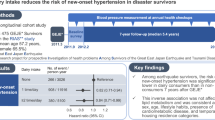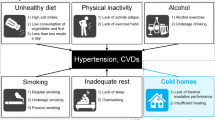Abstract
Survivors of the Great East Japan Earthquake in 2011 had higher risks of cardiovascular diseases and hypertension, particularly residents of heavy flooding areas and evacuees. Thus far, the association between the prevalence of hypertension and dairy consumption remains unknown among these evacuees. We investigated this association by housing type after the Great East Japan Earthquake. In this cross-sectional study, we conducted a baseline survey among 9569 survivors of the earthquake, aged ≥18 years, between September 2011 and February 2012. Hypertension was defined as a systolic/diastolic blood pressure ≥140/90 mmHg or as persons undergoing treatment for high blood pressure. The frequency of dairy consumption was determined using a questionnaire. Participants living in prefabricated housing and emergency shelters were regarded as residents of temporary housing. Hypertension was prevalent among 43.8% and 44.7% of the participants in temporary and non-temporary housing, respectively. A logistic regression analysis of the prevalence of hypertension by daily dairy consumption showed that the magnitude of multivariable-adjusted odds ratios differed according to housing type (odds ratio, 0.64; 95% confidence interval, 0.51–0.80 in temporary housing; odds ratio, 0.85; 95% confidence interval, 0.73–0.995 in non-temporary housing; P for interaction = 0.0501). These associations were consistent across subgroups according to sex, age, behavioral factors, obesity, disorders of lipid metabolism, and economic status. A higher frequency of dairy consumption was associated with a lower prevalence of hypertension among community-dwelling survivors of earthquakes and tsunamis, particularly those living in temporary housing. Therefore, dietary therapy involving dairy consumption could help prevent hypertension among evacuees.
This is a preview of subscription content, access via your institution
Access options
Subscribe to this journal
Receive 12 digital issues and online access to articles
$119.00 per year
only $9.92 per issue
Buy this article
- Purchase on Springer Link
- Instant access to full article PDF
Prices may be subject to local taxes which are calculated during checkout
Similar content being viewed by others
References
Iwate Prefecture. IWATE Moving toward Reconstruction. 2014. https://www.pref.iwate.jp/_res/projects/default_project/_page_/001/002/302/iwatefukkounoayumi.pdf. Accessed 28 May 2020.
Takahashi S, Yonekura Y, Sasaki R, Yokoyama Y, Tanno K, Sakata K, et al. Weight gain in survivors living in temporary housing in the tsunami-stricken area during the recovery phase following the Great East Japan Earthquake and Tsunami. PLoS ONE. 2016;11:e0166817.
Nakamura M, Tanaka F, Komi R, Tanaka K, Onodera M, Kawakami M, et al. Sustained increase in the incidence of acute decompensated heart failure after the 2011 Japan Earthquake and Tsunami. Am J Cardiol. 2016;118:1374–9.
Nakamura M, Tanaka K, Tanaka F, Matsuura Y, Komi R, Niiyama M, et al. Long-term effects of the 2011 Japan Earthquake and Tsunami on incidence of fatal and nonfatal myocardial infarction. Am J Cardiol. 2017;120:352–8.
Ohira T, Hosoya M, Yasumura S, Satoh H, Suzuki H, Sakai A, et al. Evacuation and risk of hypertension after the Great East Japan Earthquake: The Fukushima Health Management Survey. Hypertension. 2016;68:558–64.
Takahashi S, Nakamura M, Yonekura Y, Tanno K, Sakata K, Ogawa A, et al. Association between relocation and changes in cardiometabolic risk factors: a longitudinal study in tsunami survivors of the 2011 Great East Japan Earthquake. BMJ Open. 2016;6:e011291.
Soedamah-Muthu SS, Verberne LD, Ding EL, Engberink MF, Geleijnse JM. Dairy consumption and incidence of hypertension: a dose-response meta-analysis of prospective cohort studies. Hypertension. 2012;60:1131–7.
Ralston RA, Lee JH, Truby H, Palermo CE, Walker KZ. A systematic review and meta-analysis of elevated blood pressure and consumption of dairy foods. J Hum Hypertens. 2012;26:3–13.
Takashima Y, Iwase Y, Yoshida M, Kokaze A, Takagi Y, Taubono Y, et al. Relationship of food intake and dietary patterns with blood pressure levels among middle-aged Japanese men. J Epidemiol. 1998;8:106–15.
Umesawa M, Kitamura A, Kiyama M, Okada T, Shimizu Y, Imano H, et al. Association between dietary behavior and risk of hypertension among Japanese male workers. Hypertens Res. 2013;36:374–80.
Saito A, Okada E, Tarui I, Matsumoto M, Takimoto H. The association between milk and dairy products consumption and nutrient intake Adequacy among Japanese adults: analysis of the 2016 National Health and Nutrition Survey. Nutrients. 2019;11:2361.
Beydoun MA, Gary TL, Caballero BH, Lawrence RS, Cheskin LJ, Wang Y. Ethnic differences in dairy and related nutrient consumption among US adults and their association with obesity, central obesity, and the metabolic syndrome. Am J Clin Nutr. 2008;87:1914–25.
Ministry of Health, Labour and Welfare. The National Health and Nutrition Survey. https://www.mhlw.go.jp/bunya/kenkou/kenkou_eiyou_chousa.html . Accessed 31 March 2020.
Yokoyama Y, Otsuka K, Kawakami N, Kobayashi S, Ogawa A, Tannno K, et al. Mental health and related factors after the Great East Japan earthquake and tsunami. PLoS ONE. 2014;9:e102497.
Nishi N, Yoshimura E, Ishikawa-Takata K, Tsuboyama-Kasaoka N, Kubota T, Miyachi M, et al. Relationship of living conditions with dietary patterns among survivors of the great East Japan earthquake. J Epidemiol. 2013;23:376–81.
Shen M, Tan H, Zhou S, Smith GN, Walker MC, Wen SW. Trajectory of blood pressure change during pregnancy and the role of pre-gravid blood pressure: a functional data analysis approach. Sci Rep. 2017;7:6227.
Yoshimura E, Ishikawa-Takata K, Hasegawa Y, Murakami H, Nozue M, Sarukura Y, et al. The food intakes in the survivor of the Great East Japan Earthquake living in temporary houses in Kamaishi city. Iwate Koshu Eisei Zasshi. 2014;25:7–14.
Murakami H, Yoshimura E, Ishikawa-Takata K, Hasegawa Y, Kubota T, Tsuboyama-Kasaoka N, et al. Validity and reproducibility of a physical activity questionnaire used for health surveying among victims of the Great East Japan Earthquake. Nihon Koshu Eisei Zasshi. 2013;60:222–30.
Wang H, Fox CS, Troy LM, McKeown NM, Jacques PF. Longitudinal association of dairy consumption with the changes in blood pressure and the risk of incident hypertension: the Framingham Heart Study. Br J Nutr. 2015;114:1887–99.
Livingstone KM, Lovegrove JA, Cockcroft JR, Elwood PC, Pickering JE, Givens DI. Does dairy food intake predict arterial stiffness and blood pressure in men? Evidence from the Caerphilly Prospective Study. Hypertension. 2013;61:42–7.
WHO. Guideline: sodium intake for adults and children. 2012. https://apps.who.int/iris/bitstream/handle/10665/77985/9789241504836_eng.pdf?sequence=1&isAllowed=y .Accessed 31 March 2020.
Ricci I, Artacho R, Olalla M. Milk protein peptides with angiotensin I-converting enzyme inhibitory (ACEI) activity. Crit Rev Food Sci Nutr. 2010;50:390–402.
Shiozaki Y, Nishikawa E, Deguchi T. Lessons from the Great Hanshin Earthquake. Creates-Kamagawa Publishers; 2005.
Zhang W, Ohira T, Abe M, Kamiya K, Yamashita S, Yasumura S, et al. Evacuation after the Great East Japan Earthquake was associated with poor dietary intake: the Fukushima Health Management Survey. J Epidemiol. 2017;27:14–23.
Takahashi E, Sasaki N, Takeda J, Ito H. The geographic distribution of cerebral hemorrhage and hypertension in Japan. Hum Biol. 1957;29:139–66.
Kato K, Ishida S, Tanaka M, Mitsuyama E, Xiao JZ, Odamaki T. Association between functional lactase variants and a high abundance of Bifidobacterium in the gut of healthy Japanese people. PLoS ONE. 2018;13:e0206189.
Acknowledgements
We thank Editage by Cactus (www.editage.com) for the English language editing.
Funding
This study was supported by Grant in Aid from the Ministry of Health, Labor and Welfare, Health and Labor Sciences Research Grants, Japan (H23-Tokubetsu-Shitei-002; H24-Kenki-Shitei-001, H25-Kenki-Shitei-001(Fukkou)), and the Dairy Products Health Science Council and the Japan Dairy Association.
Sponsor’s role
None of the study sponsors had any role in the study design, conduct of the study, data collection, data interpretation, or preparation of the manuscript.
Author information
Authors and Affiliations
Corresponding author
Ethics declarations
Conflict of interest
The authors declare no competing interests.
Additional information
Publisher’s note Springer Nature remains neutral with regard to jurisdictional claims in published maps and institutional affiliations.
Supplementary information
Rights and permissions
About this article
Cite this article
Miyagawa, N., Tsuboyama-Kasaoka, N., Nishi, N. et al. Association between the prevalence of hypertension and dairy consumption by housing type among survivors of the Great East Japan Earthquake. J Hum Hypertens 36, 299–307 (2022). https://doi.org/10.1038/s41371-021-00500-z
Received:
Revised:
Accepted:
Published:
Issue Date:
DOI: https://doi.org/10.1038/s41371-021-00500-z



